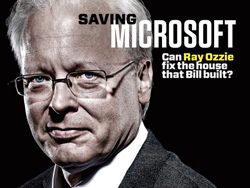One of our core themes for the connected world, is that we are living through an unprecedented confluence of new technologies that unleashes innovation and fundamentally transforms industries. In keeping with this view, in the last few months we have seen a tremendous wave of new technology products and developments from a wide range of companies. Taken separately, many of these announcements are significant and a few are game-changing, not so unusual for our industry. However, when viewed collectively they add up to nothing less than a new revolution in personal computing.
Innovation is happening at every level of personal systems, from processor architecture and devices to social media and advertising. The very idea of a personal system is broadening rapidly to encompass mobile, embedded and cloud systems, identity, context and the physical world.
In core hardware, Qualcomm’s Snapdragon platform garnered significant design wins at HP, Google and many others, while Apple has developed their own ARM-based A4 system on a chip. Nvidia also apparently gained support for their new Tegra2 mobile processor.
In system software, Google released the open source Chromium OS while their Android platform continued to gather design wins. Microsoft announced a completely redesigned Windows Phone 7 OS, Intel and Nokia merged Moblin and Maemo into the MeeGo linux platform, Symbian3 launched, and Apple extended their iPhone OS to a major new platform.
In devices, Apple announced the iPad, Google jumped into the hardware business with the Nexus One, HP and others previewed tablet PCs, and a stack of new E-readers launched from Barnes & Noble, Hearst, Plastic Logic, and more.
Application ecosystems continued to heat up as Apple’s AppStore crossed 100,000 apps and 3 billion downloads. Intel introduced the AppUp store for netbooks, and a broad consortium of carriers and device makers launched the oddly named Wholesale Applications Community for mobile apps.
The social media frenzy continued unabated, with Facebook hitting 400 million users (third in country population behind China and India!), Twitter passing 1 billion tweets per month, and Google’s Buzz launching like a rocket with millions of users before running into a buzzsaw of criticism for their tone-deaf approach to privacy and usability. A recent analysis showed Facebook driving more traffic to major web destinations than Google, signalling a dramatic shift from organic search to friend recommendations for finding information online.
Google acquired AdMob while Apple bought Quattro Wireless, pointing to a major battle for mobile advertising as well as a very provocative business model play for Apple.
Mobile social location-based gamers Foursquare, a favorite of the early-adopter tribe, inked deals with major media properties including Bravo TV, Conde Nast’s Lucky Magazine, Zagat guides, HBO, Warner and the New York Times.
The race to capture, index and augment the physical world further intensified. Microsoft’s Bing Maps and Google’s Street View each showed major new features, including integrating users’ photographs seamlessly into their visual canvases. Street View now has capture operations in 30 countries on 6 continents, and they are managing a fast-growing multi-petabyte store of image and lidar data (1 PB = 1 million GB). Meanwhile NYC startup Everyscape raised $6M from SK Telecom to expand their real-world capture into Asia, and SF-based Earthmine opened their high-resolution 3D city point cloud database to developers.
Google also released Goggles, a mobile app for Android devices that provides visual recognition, identification, OCR and search for physical world objects such as books, products, and landmarks. Nokia began a pilot of their mobile Point & Find service with bus shelter advertising in Colchester UK. Augmented reality startup Layar added $3.4M in funding and a global mobile phone distribution deal, signalling growing commercial interest in overlaying the real world with digital media and experiences.
In the realm of open innovation we saw grass-roots networks mount a groundswell of response to the disastrous earthquake in Haiti. Open source platform Ushahidi, mapping and geoweb experts from Open Street Map, and hackers at worldwide self-organizing Crisis Camps provided tools and expertise to support a wide range of relief efforts on the ground in Port au Prince.
Lastly, in two fascinating signs that the future is upon us, HP announced that it was getting into 3D printers through a deal with Stratasys, while San Diego outfit Organovo announced the first commercial 3D bio-printer for manufacturing human tissue and organs. It really doesn’t get much more personal than that.
In the 40-plus years since Douglas Engelbart created the mother of all demos, the personal computer has fundamentally transformed the way we work, play, create, communicate, shop, learn and live. Now we find ourselves at the cusp of a new revolution, where personal computing is no longer synonymous with the personal computer. The new personal computing is mobile, embedded, networked, virtual, social, contextual, wearable and physical. And it’s here. Are you ready?

